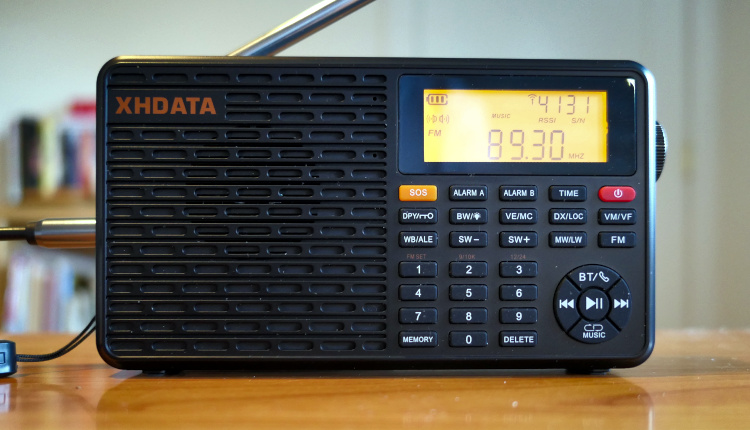
Introduction
With the prospect of tariffs imminent from the administration taking office in 2025, I decided it was time to buy a radio that I was always on the fence about buying. The XHDATA D-109WB is a version of that company's XHDATA D-109 that's intended specifically for North America. You can tell because it includes the band where governmental weather radio is broadcast, which is something not present outside the U.S. or Canada. Weather-band coverage is rare in this category of "ultralight" receivers; the only other such model that I know of that covers this band is the C. Crane CC Skywave.
There's more to the XHDATA D-109WB than added weather-band coverage, though. It also can play music files stored on a microSD card, and it can connect to computing devices via Bluetooth to serve as an external speaker. Even more notable, it cost just over $40 in late 2024. Are there compromises from packing so many features into a small package costing that little? Short answer is, yes, but there aren't many of them.
The XHDATA D-109WB as a radio
The D-109WB has a basic layout similar to many other DSP-based radios. There's a keyboard for directly entering a desired station's frequency, and there's also a tuning knob for changing channels. Unlike similar radios in this class, most buttons have only one function. The buttons are relatively small but don't seem difficult to use. They are rubberized, which may present problems in the future (see my review of the CC Pocket Radio and the Grundig G8/Tecsun PL-300WT for some examples).
There are two alarms and five AM audio bandwidths (6, 4, 3, 2, and 1 kHz) selectable from the front panel. The band to listen to is selected with one of the buttons in the row that's immediately above the numeric buttons. Automatic memory storage of scanned stations is also triggered with this row of buttons. The large circular control to the right of the numeric buttons is used with the unit's media player, including Bluetooth connections.
The orange button labeled SOS is something I haven't found on other radios. A long press on this button causes the radio to light up and sound a distress alarm. Pressing the SOS button again turns off the alarm.
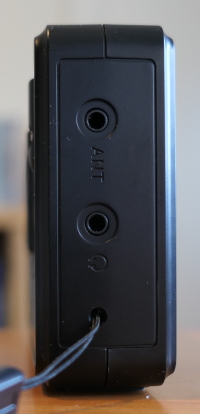
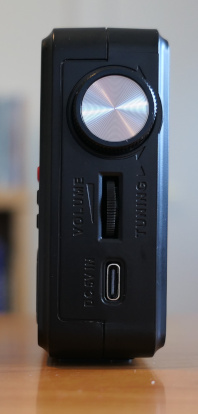
The left side of the radio (see far left) has a jack for an external FM or shortwave antenna, something unusual to find in a radio at this price point. The earphone jack will work with TRRS plugs, which are the plugs found with earbuds that have a microphone included. The D-109WB isn't an audio recorder, though.
The right side of the radio (see near left) has a tuning knob, a thumbwheel to control speaker volume, and a USB-C port for charging. The radio comes with a 18650 lithium-ion battery, capacity 2000 mAh, which fits very snugly into the battery compartment. The battery charges at a fairly normal rate; a fast charger shouldn't be needed.
Tuning with the tuning knob is somewhat annoying. As with earlier DSP models such as the Tecsun PL-310ET or the Tecsun PL-380, the D-109WB has a two-speed tuning approach. Initially it tunes in small steps; if you keep turning after a second, it tunes in larger steps. The tuning step isn't fixed. This is particularly irritating when tuning to a station close to the one you've been listening to. It's very easy to overshoot. It's hard to get the radio tuned to its precise frequency this way.
Small tuning steps for AM are 1 kHz; 10 kHz for FM. The large tuning step is 9 or 10 kHz for AM (depending upon the level that you've set) or 100 kHz for FM. Even larger steps aren't available. This could have been at least something of a mitigating factor; as it is, tuning with the knob across a band is usually kind of slow.
You can also tune with the "back" and "forward" portions of the large circular control, but that's even slower: the tuning steps are always 1 kHz for AM and 10 kHz for FM. Holding down the control doesn't make the tuning go any faster.
The best ways to tune the radio are either to enter the frequency directly on the keyboard, or use its memory functions, where the tuning knob will tune between just stored frequencies rather than all frequencies in a given band.
As with many other radios of this type, there's a kind of tone control, using the voice/music (VE/MC) button to switch between the two modes. Normally with filters of this type, it's the music mode that provides a flat frequency response, with the voice mode enhancing the audio frequencies where speech is heard, or reducing the bass, or both.
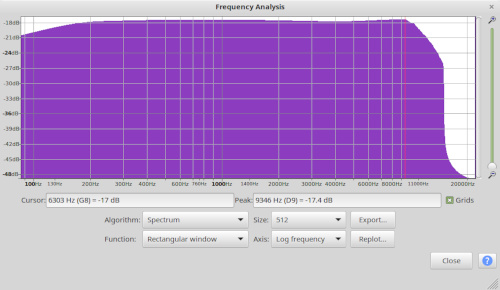
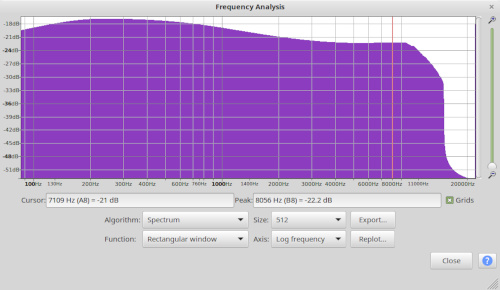
Very strangely, in my opinion, the D-109WB has a flat frequency response in its voice mode rather than its music mode, as can be seen at far left. At near left, you see the response in the music mode, which starts rolling off gently at 500 Hz and flattens out at about 5 kHz, down 6 dB.
(The rolloffs at 200 Hz and about 10 kHz seem to be an artifact of the setup that I use for testing and aren't a result of anything the D-109WB is doing.)
My guess - and this is only a guess - is that the rolloff in the music mode is intended to make the speaker sound a little richer than it otherwise would. That is indeed the case; the speaker in the radio is pleasant to listen to. It's not hi-fi by any stretch of the imagination, but it doesn't have the shrill quality that some radios in this category have. The speaker also sounds reasonably decent in voice mode, though with more treble. The speaker diameter is 40mm, or about an inch and a half. The specification for the radio says that it has a five-watt amplifier.
The reversal of the voice and music modes, compared to what you'd normally get in a radio of this type, is something you have to watch out for if you're making recordings from it. For best results, meaning a flat frequency response, you'll have to remember to set the radio in voice mode and not in music mode.
When tuned to the weather band, the radio is always in voice mode.
Using the weather band
Tuning the weather band is much simpler than other bands, since there are only seven weather-radio channels.
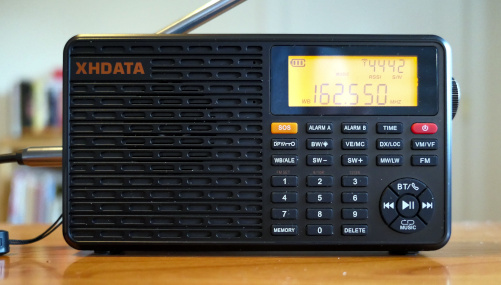
Most weather radios tune by channel numbers, but the XHDATA instead shows the exact frequency (see right). This doesn't present a big difficulty: channel 1 is 162.40 MHz, channel 7 is 162.55 MHz, and the channels are spaced 50 kHz (0.05 MHz) apart.
Stations in the weather band can't be tuned with the numeric keypad. You have to use either the tuning knob or the large circular control to switch channels in the weather band.
The radio can also listen for alerts on a designated weather-band station even while the rest of it is off. This function does consume battery power, so you may want to use it only when severe weather is imminent. When an alert is received, the radio will light up and beep.
Weather band performance
When I lived in the San Francisco Bay Area, I had five or six weather radio stations to choose from, with the hilly terrain of the area providing a good test of a radio's ability to pick up these signals. In the Denver area, the terrain where I live is much flatter, and there are three weather radio stations in the vicinity.
I compared the D-109WB's performance to that of two other radios that pick up the weather band: the C. Crane CC Skywave, and the Sangean DT-400W. Both of those models performed well in Bay Area testing.
The stations in the Denver area are on 162.45 MHz (channel 3), 162.475 MHz (channel 4), and 162.55 MHz (channel 7). The D-109WB performed about as well as the comparison radios on channels 4 and 7; it had trouble picking up channel 3 that the other two models could receive fairly well. So I would say that the D-109WB is sensitive enough for most circumstances, since you only need one weather-band station to have access to the service. Still, it was not as strong a performer as the C. Crane or Sangean models.
The XHDATA D-109WB as a media player and external speaker
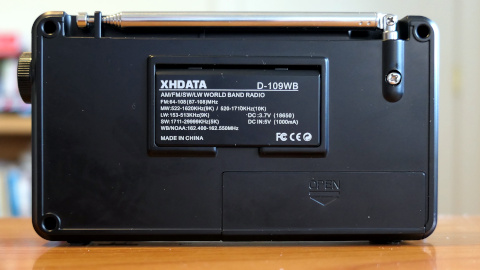
As you might surmise from the text on the back of the unit (left), the D-109WB is primary a radio, with its media player functions being secondary to its main purpose. This is reflected in the D-109WB's bare-bones functionality for playing audio files from a microSD card.
Assuming a card is in the device, you start up the media player by pressing the bottom portion of the large circular control on the front of the unit. There is a play and pause button in the center of that control. The maximum card capacity supported is 32 GB. The unit supports the MP3, WMA, WAV, and lossless FLAC formats, organizing the files in the order that they were added to the card. It doesn't support other formats, particularly Ogg Vorbis, which is popular among Linux users.
Due to the limitations of the display, no metadata can be shown. What is shown is the "number" of the file in the upper right corner of the display. Files can be accessed by pressing the back or forward (left or right) portions of the large circular control.
Not documented in the (rather skimpy) owner's manual is the ability to directly access a file by its number. This is done by pressing the number of the file in the numeric keypad. Of course, you have to know the number of the file you want to get, which isn't easy.
The D-109WB isn't going to replace a music player, whether a dedicated device or an app on your phone or tablet. It's probably best for situations where you have a few files that are podcasts, airchecks, or other long-form types of audio.
The music/voice filter is still active when using the media player. Thus, if you want flat frequency response from your audio files, you'll need to make sure that the "voice" position is selected with the VE/MC switch.
Setting up the D-109WB as an external Bluetooth speaker is as simple as pressing the BT/phone icon portion of the large circular control on the front of the unit and then pairing it with the device that's transmitting Bluetooth.
Radio performance
I'll note my usual disclaimer here: I'm interested in AM and FM reception. I'm not interested in shortwave reception, and haven't evaluated functions or performance related to shortwave on this radio except in so far as they're relevant to AM reception. I'm most interested in FM reception.
From using the D-109WB over a period of several weeks, I've gotten the impression that it would have been considered a great radio in the 1990s and early 2000s, comparable to the first generation of DSP-based radios, but surpassed by newer models such as the Qodosen DX-286. Similar to the head-to-head comparison that I did in August 2024, I decided to do another comparison, this time with the D-109WB, using the same scoring methodology that I used in August 2024. Note that variations in reception conditions may also cause performance rankings to vary, since these radios are all really very close in sensitivity and selectivity.
I've posted the details of this December 2024 comparison for both AM reception and FM reception.
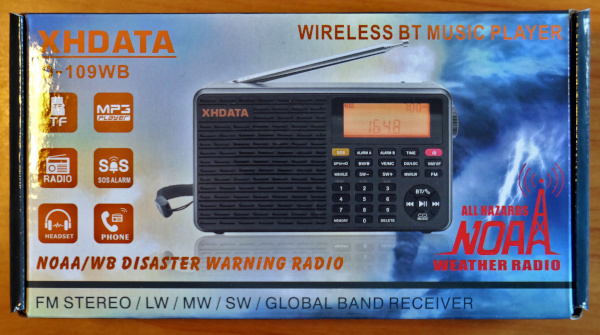
To summarize, the AM performance of the XHDATA D-109WB was comparable to those of first-generation DSP radios (Tecsun PL-310ET and Tecsun PL-380). It lagged behind the two second-generation DSP radios that were compared, the Tecsun PL-320 and the Qodosen DX-286.
I was not able to test longwave reception on the D-109WB, due to the absence of such broadcast stations in North America.
On FM, the performance of the D-109WB was slightly worse than the Tecsun first-generation models, though within an arbitrary margin of error. As with AM, the leading models for FM reception were the Tecsun PL-320 and, by far and away the most sensitive, the Qodosen DX-286.
One other note: the display has a pleasant yellow backlight, but the numbers in the display are unusually dim. The viewing angle is very narrow as well. To see the display well, you have to be looking at it head-on. This is something that really needs to be improved.
Conclusion
As I mentioned elsewhere in this review, all the radios compared would've been considered very good in the 1990s and early 2000s. The state of the technology has advanced since then and, especially since 2020 or so, newer radios are achieving even better results. Consequently, the D-109WB seems to be a bit of a throwback to a decade earlier. While it's still a very good performer, there are better choices if what you're mainly looking for is a radio. What the XHDATA D-109WB has to offer is additional versatility through its media-player and Bluetooth speaker functions. It's one of the few radios in the "ultralight" category that includes reception of the weather-radio band. The speaker's audio quality is surprisingly good. The price is also very attractive.